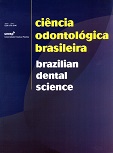Propriedades físicas dos fios de sutura usados na odontologia
DOI:
https://doi.org/10.14295/bds.2007.v10i2.344Abstract
Objetivo: investigar as características físicas dos fios de sutura freqüentemente usados na odontologia. Material e Método: Fios (n=10) de seda (FS) 4-0 e nylon (FN) 4-0 (Somerville Ltda.) foram testados de acordo com a norma NBR 13904:2003. O comprimento foi determinado com escala rígida, sem tensionar o fio. O diâmetro foi avaliado utilizando um metroscópio e um relógio comparador digital. As cargas de ruptura em tração sobre nó (Lno) e ao encastoamento (Lf) foram testados em uma máquina de ensaio universal com velocidade de 1mm/min. Os resultados foram analisados estatisticamente pelo teste t de Student (α = 0,05). Resultados: Todos os fios cumpriram com as especificações quanto ao comprimento. Os FN apresentaram um valor médio de diâmetro de 0,17 mm, contudo os FS apresentaram um valor médio de 0,21 mm, ficando fora da faixa específica (0,15-0,199 mm). Valores médios de Lno foram significativamente maiores para os FS (7,54 ± 0,50 N) do que para os FN (6,67 ± 0,83 N) (p<0,05). Todos os fios resistiram ao teste de encastoamento com valores acima dos limites individual e médio mínimos preconizados, respectivamente 2,26 N e 4,41 N, sendo que os valores médios de FS (8,98 ± 2,16 N) foram significativamente maiores do que os FN (7,27 ± 1,31 N) (p<0,05). Conclusão: Essas diferenças podem ter sido induzidas pelo maior diâmetro dos FS, pois assumindo os valores médios de diâmetro e carga obtem-se valores de resistência a tração sobre nó (σno) de 203,8 MPa para os FS e 277,9 MPa para os FN.Downloads
Downloads
Published
How to Cite
Issue
Section
License
Brazilian Dental Science uses the Creative Commons (CC-BY 4.0) license, thus preserving the integrity of articles in an open access environment. The journal allows the author to retain publishing rights without restrictions.
=================




























